


But do not get obsessed with the idea of racing through the word lists to the finish line. Q: How long will it take to get through a whole word list? I want my child to learn ALL the words!!!Ī: That depends on a number of factors, including frequency of your lessons as well as your child’s ability to focus. Children who learn quickly may only need to use two or three of the techniques.

If the child learns fine without Table Writing, then you can try leaving out the fourth technique, Air Writing. Start by eliminating the last activity, Table Writing, but be sure to review those words at the next lesson to see if the child actually retained them without that last exercise. After a few weeks of lessons, you will have a sense for how long it takes your child to learn new words and whether all five exercises are necessary. The techniques use different teaching methods and physical senses to support and reinforce the child’s memorization of the word. Q: Do I really need to do all five techniques for every word?Ī: Start out by using all five techniques with each new word. Give him time to grow confident with his current set of words, and avoid overwhelming the child with new words when he hasn’t yet become familiar with the old words.
OUTLINE TO MAKING BINGO TEMPLATES ON MICROSOFT WORD HOW TO
The child is learning how to learn the words and is developing pattern recognition approaches that will speed his progress. We have been on the same five words for a week!Ī: It is not unusual to have to repeat the same set of words several times, especially in the first weeks of sight words instruction. All you need is a flash card for each of the sight words you are covering in the lesson. The lessons get the child up to a baseline level of competence that is then reinforced by the games, which take them up to the level of mastery. The exercises combine many repetitions of the word (seeing, hearing, speaking, spelling, and writing) with physical movements that focus the child’s attention and cement each word into the child’s long-term memory. These techniques work together to activate different parts of the brain.

NOTE: Be sure the child has a pretty good grasp of a sight word before using it in a game, especially if you are working with a group of children. The games are of course the most entertaining part of the sight words program, but they need to wait until after the first part of the sight words lesson. We have numerous sight words games that will make that repetition fun and entertaining for you and your child. Learning sight words takes lots of repetition. Use your game time to provide lots of repetition for these words until the child has thoroughly mastered them. Note: The child should have a good grasp of - but does not need to have completely mastered - a word before it gets replaced in your lesson plan. If he has trouble with more than two of the review words, then set aside the new words you were planning to introduce and devote that day’s lesson to review. If your child struggles to recognize a word, cover that word again in the main lesson, going through all five teaching techniques. Go through the See & Say exercise for each of the review words. Remember: solid knowledge of a few words is better than weak knowledge of a lot of words! Words often need to be covered a few times for the child to fully internalize them. 2.2 Review Old Wordsīegin each subsequent lesson by reviewing words from the previous lesson. As your child gets more advanced, you might increase the number of words you work on in each lesson. This part of a sight words session should be brisk and last no more than ten minutes. This lesson should establish basic familiarity with the new words. Then introduce the second word, and go through all five teaching techniques, and so on. Hold up the flash card for the first word, and go through all five techniques, in order. Introduce one word at a time, using the five teaching techniques. When first beginning sight words, work on no more than three unfamiliar words at a time to make it manageable for your child.


 0 kommentar(er)
0 kommentar(er)
